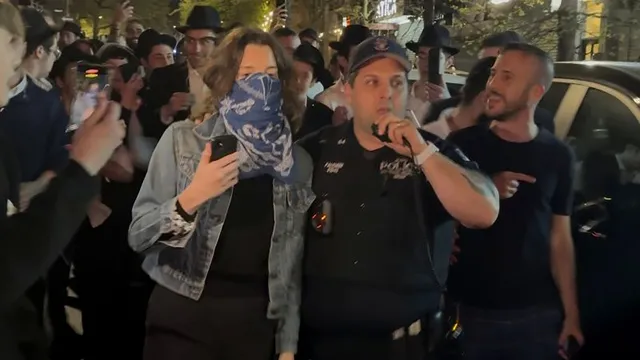
Brooklyn woman assaulted by mob mistaken for protester at Jewish rally
2025-04-29 01:42- A woman in her 30s was chased, assaulted, and threatened by a crowd of Orthodox Jewish men in Brooklyn after being misidentified as a protester.
- The occurrence coincided with protests against Itamar Ben-Gvir, igniting tensions between different community groups.
- This incident underscores the need for safety and dialogue within communities in the face of rising political and social divides.
Express your sentiment!
Insights
In New York City, a violent incident unfolded on Thursday near the Chabad-Lubavitch headquarters in Brooklyn's Crown Heights neighborhood, where a woman in her 30s faced a mob after being mistakenly identified as a pro-Palestinian protester. The event coincided with an appearance by Itamar Ben-Gvir, Israel's far-right security minister, which led to clashes between protesters and the local Orthodox Jewish community. The woman, hearing helicopters over her apartment, ventured out to investigate the scene around 10:30 p.m., seeking to avoid being filmed due to a heightened tension in the area. Without participating in the protest, she covered her face with a scarf to prevent being recognized, triggering aggressive behavior from a large group of men who encircled her. They began shouting threats, including sexual violence and chants of 'death to Arabs,' creating an atmosphere of fear and apprehension for the woman. Despite her pleas and the evident chaos, the police did not intervene until the situation escalated significantly, with the woman being shoved around and attacked, resulting in blood streaming down her face. Following her apprehension by a police officer, the mob's hostility intensified, calling out for her capture. The officer was able to escort her to safety by getting her into a police vehicle. This incident speaks volumes about the recent tensions surrounding the protests against Ben-Gvir, a polarizing figure known for his extreme nationalist views and previous convictions in Israel for incitement. The protests sparked substantial discourse, with certain Jewish groups condemning the reactions of the mob, highlighting the historical significance of the Crown Heights neighborhood, which was previously the site of severe racial tensions. New York City Mayor Eric Adams condemned the violence and supported peaceful protests, ensuring that illegal activities would not be tolerated. The incident raises concerns about the safety of citizens in heated demonstrations and serves as a reminder of the ongoing struggles regarding polarizing views on the Israeli-Palestinian conflict. As calls for justice and accountability grow, the need for discussions on anti-Semitism, freedom of speech, and community safety has become increasingly critical in the wake of this disheartening event. As both the mayor and community leaders urged for a more peaceful and understanding dialogue, the overall implications of this violent episode extend beyond individual suffering. They highlight the soaring division within society stemming from complexities in the discourse surrounding national identity, personal beliefs, and the larger geopolitical narratives at play.
Contexts
The Chabad-Lubavitch movement, founded in the late 18th century, has its headquarters in Crown Heights, Brooklyn, a neighborhood that has become the heart of its activities and outreach efforts. This location was chosen for its strategic importance to establish a center of Jewish life, education, and community engagement. The movement was launched by Rabbi Schneur Zalman of Liadi and adheres to a philosophy that blends Jewish mysticism and spirituality with proactive community outreach. Over the years, Crown Heights has transformed into a vibrant and diverse Jewish community with a significant number of Chabad centers worldwide, reflecting the Lubavitcher Rebbe's emphasis on global outreach and education. The Crown Heights headquarters, known as 770 Eastern Parkway, was established in the early 20th century and has served as the epicenter of Chabad activity since then. It is here that the last Lubavitcher Rebbe, Rabbi Menachem Mendel Schneerson, led the movement from the 1950s until his passing in 1994. The building is not only a synagogue but also houses educational institutions, a library, and community programs that serve thousands of visitors each year. The Rebbe's teachings continue to inspire Jews worldwide, making 770 a pilgrimage site for those seeking spiritual guidance and connection with the Lubavitch philosophy. Crown Heights has faced its share of challenges, including tensions related to cultural differences within an increasingly diverse urban landscape. Nevertheless, the Chabad community has worked diligently to foster a welcoming environment through outreach programs, education initiatives, and interfaith dialogue. This commitment to community building showcases the resilience and adaptability of the Chabad mission, which focuses on the universal tenets of love, respect, and responsibility for one’s fellow human being. The impact of the Chabad-Lubavitch headquarters on both local and global Jewish communities cannot be overstated. Through a wide array of programs, including kosher food distribution, educational lectures, holiday celebrations, and youth engagement activities, the movement has successfully integrated its teachings into the everyday lives of countless individuals. As Chabad-Lubavitch continues to expand its influence and charitable work, the headquarters in Crown Heights remains a symbol of hope and spiritual revitalization for many, upholding its important legacy while adapting to the changing dynamics of modern society.